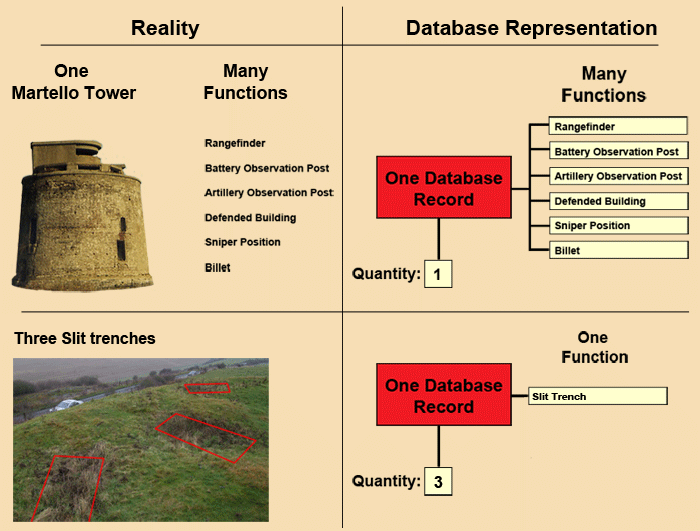Lies, damn lies and statistics...
Posted: 26 March 2009 21:33
I've been asked to explain my list of statistics generated by my main database to appear on the homepage. So if you want to know how many defence works I've recorded so far, there's a few things you need to get your head round.
How many defence works? My stats currently read as follows:
- 1624 records (52 have 2+ functions)
- 1675 functions
- 1828 features
A set of seemingly meaningless statistics, but they illustrate the difficulty of recording features in a database. The purpose of a database is to reflect certain aspects of reality, i.e. that certain structures exist or once existed.
But it's not as simple as that, as many features might have had more than one function. The diagram below explains how I deal with multiple roles undertaken by a single structure and how I record multiple identical features such as slit trenches.

Database purists are probably feeling quite faint and desperately clutching their favourite entity-relationship diagram in horror at how I'm tackling the slit trench example, but I use this rather odd method for a reason. Strictly speaking I should have one database record for each of the three trenches, but there comes a time when this would get to be too much.
For instance, a document may list two pillboxes and three trenches at the same location. Under my way of doing things, each pillbox is significant enough to warrant its own record, whereas the trenches get one record for all of them, as there is little hope of ever being able to distinguish each one as an individual. A pillbox, however, is large enough to identify from aerial photographs, possibly appears on German intelligence material and is more likley to be located from other sources and fieldwork than a batch of anonymous trenches.
Another need to record more than one defence work within one database record arises when I don't know how many works there were. An example is the following set of extracts from a Royal Engineers diary:
- 8th July 1940: Contracts with 4 civilian contractors signed for placing buildings in a state of defence at Battle.
- 9th July 1940: Contracts with 2 civilian contractors signed for placing buildings in a state of defence at Battle.
- 11th July 1940: Contracts signed with 8 civilian contractors for placing buildings in a state of defence at Baldslow and Battle.
- 12th July 1940: Contracts signed with 7 civilian contractors for placing buildings in a state of defence at Battle.
- 17th July 1940: Contracts signed by 5 civilian contractors for placing buildings at Battle in a state of defence.
How many defended buildings do we have and where? Does each contractor work on one building, or more than one? Does more than one contractor work on the same building? The only probable result from all this data is that there are 2+ defended buildings in Battle and 2+ in Baldslow and this is where a quantity field in the database is useful.
So to summarise: if one defence work has multiple functions it has one database record. If a number of identical works only have one (same) function, they are recorded together in a single record that records their quantity.
So how many defence works? As I hope has become apparent, there's no one simple figure.
Confused? Welcome to statistics!
- Pete

Email:
Blog Latest

Bishopstone reveals its pillbox secrets
18 October 2021

Pillbox or Observation Post?
10 June 2020

Uncovering the hidden secrets of a pillbox
8 June 2019

Review of 2018
31 December 2018

Wartime Christmas in East Sussex (2)
24 December 2018
Jargon-buster
Defended building
An existing building occupied as a fighting position, usually incorporating some form of fortification such as sandbagging, shoring up of ceilings or cutting of loopholes in external walls.
Pillbox
Generic term for a hardened field defensive structure usually constructed from concrete and/or masonry. Pillboxes were built in numerous types and variants depending on location and role.
Slit trench
Small, narrow trench designed to provide protection against shrapnel and other battlefield hazards. Technically distinct from a weapon pit (which was intended soley as a defensive position) slit trenches were also used as defence works.
This site is copyright © Peter Hibbs 2006 - 2024. All rights reserved.
Hibbs, Peter Lies, damn lies and statistics... (2024) Available at: http://www.pillbox.org.uk/blog/216619/ Accessed: 25 April 2024
The information on this website is intended solely to describe the ongoing research activity of The Defence of East Sussex Project; it is not comprehensive or properly presented. It is therefore NOT suitable as a basis for producing derivative works or surveys!